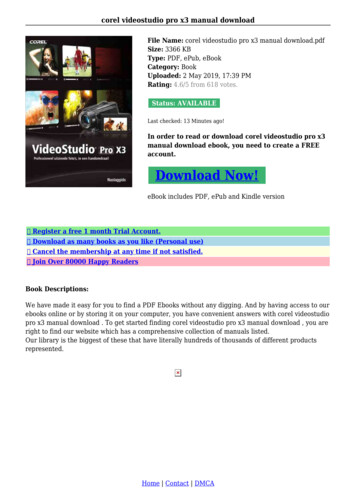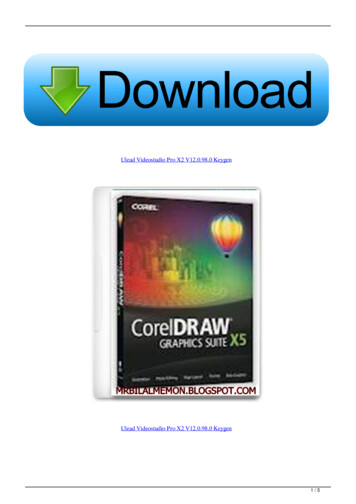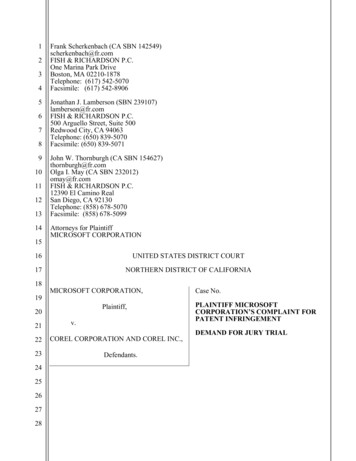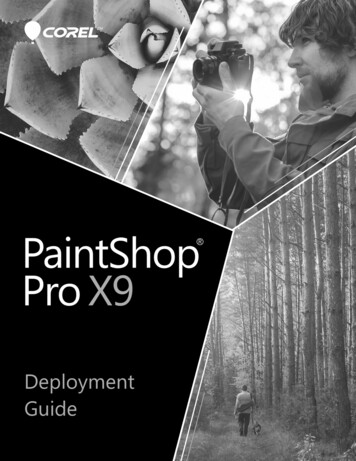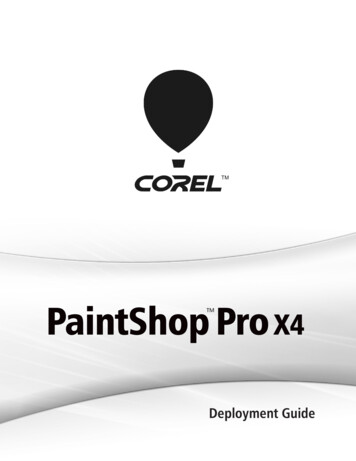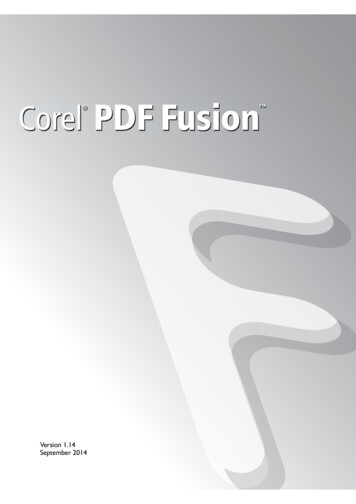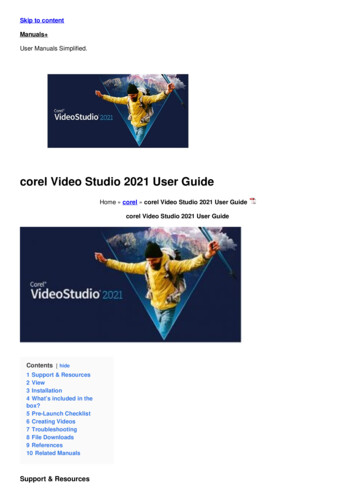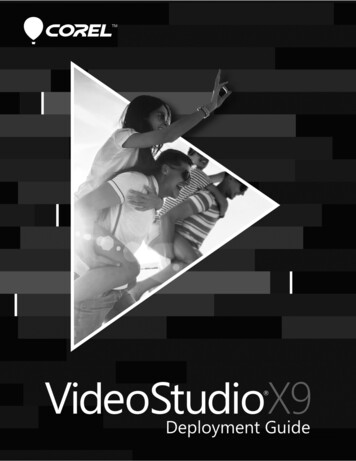
Transcription
IntroductionAs you read through this guide,you’ll find that the right column ofeach page contains the maincontent, while the left columncontains the following categoriesof information:definition — explains theitalicized term or concepttip — presents a helpfuldetail, such as a shortcut,variation, or benefitnote — presents anadditional detail about thespecified topic or taskwarning — presents acrucial detail about thespecified topic or taskThe left column also gives youroom to make notes.This guide is intended to help you deploy Corel VideoStudio Pro X9(Corporate and Education Edition) to your network as quickly and easily aspossible.ContentsStage 1: Preparing for deployment . . . . . . . . . . . . . . . . . . . . . . . . . . . . 3Stage 2: Creating the server image . . . . . . . . . . . . . . . . . . . . . . . . . . . . 5Stage 3: Installing the software . . . . . . . . . . . . . . . . . . . . . . . . . . . . . . 7Stage 4: Maintaining the installations. . . . . . . . . . . . . . . . . . . . . . . . . 15Additional resourcesIf you are new to software deployment or otherwise require more basicinformation on deploying Corel software products, please refer to theCorel Beginner’s Guide to Network Deployment. You can request a copyof this guide from your Corel Support Services representative.For even more information, see the following Web resources.Web resourceDescriptionCorel website: www.corel.comInformation about Corel Corporationand its portfolio of software productsCorel Support Serviceswebsite: www.corel.com/supportInformation about product features,specifications, pricing, availability,services, and technical supportCorel Knowledgebase : www.corel.com/kbA searchable repository of articleswritten by the Corel Support ServicesteamFor help with the Microsoft Windows Installer (MSI) technology that isused to install the software, please refer to the Microsoft website.Deployment GuideIntroduction2
Stage 1: Preparing for deploymentAs used in this guide, theterm “network” signifiestwo or more computersthat are connected to each otherfor the purpose of exchanginginformation.To deploy the software to your network as smoothly as possible, you canprepare by doing the following: Check the system requirements for the software. Prepare the server. Prepare the workstations.For details, see below.Checking the software requirementsWorkstations are thecomputers from which theaverage user works, andservers are the computers thatmanage the shared resources ofthe network.To begin, make sure that your server and workstations are eligible for thesoftware. Consult the following: Readme file for the software (if available) product-information page on the Corel website (www.corel.com) any other special instructions for the softwarePreparing the server Make sure that the server meets the minimum system requirements forthe software, and that it has enough free disk space for the installation. Make sure that the operating system on the server has been updatedwith the latest service packs and security patches. Make sure that you have the proper permissions for creating a softwareimage on the server. You must be either a local administrator or anadministrator for the domain that you are managing, and you musthave read/write access to the server location.Preparing the workstations Make sure that the workstations meet the minimum systemrequirements for the software, and that they have enough free diskspace for the installation. Make sure that the operating systems on the workstations have beenupdated with the latest service packs and security patches.Deployment GuideStage 1: Preparing for deployment3
To more easily manage theaccess rights of workstationusers, you may want to useGroup Policy Objects (GPOs, or“system policies”). See “Managingpermissions with Group PolicyObjects” on page 7. Make sure that anyone who will be installing the software from theserver image has the proper permissions to do so. To install thesoftware on a workstation, you must be either a local administrator oran administrator for the domain that you are managing, and you musthave read access to the server location.Deployment GuideStage 1: Preparing for deployment4
Stage 2: Creating the server imageA server image, also calledan “administrator image”or simply an “image,” is aset of uncompressed applicationfiles on the server that is createdfrom a set of compressed files onthe installation disc.After preparing for deployment, you’re ready to create a server image ofthe software, from which you can install the software to the workstations.(If you want to support multiple installation types, you can even createmultiple server images: one for each desired configuration.)ContentsCreating a server image . . . . . . . . . . . . . . . . . . . . . . . . . . . . . . . . . . . . 5Finalizing the server image . . . . . . . . . . . . . . . . . . . . . . . . . . . . . . . . . . 6Creating a server imageA command line is a textualcommand that lets youspecify desired settings.To create a server image, you run a command line that initializes thesoftware setup and specifies your desired installation settings.Important: Corel VideoStudio Pro X9 includes a 32-bit and 64-bit versionof the application. You can create a server image for each version, but theversions must be stored in separate locations and only one version can bedeployed to workstations (the 32-bit and 64-bit versions cannot co-existon workstations).To run a command line1 Open the Run dialog box (shortcut key: Windows Logo R).2 Type the command line in the Open box, and then click OK.To create a server image1 Do one of the following:To mount an ISO file, youmight require third-partysoftware that helps youcreate a virtual drive. Alternatively,you can burn the ISO file to a CD/DVD and access the files from thedisc. If you have an installation disc, insert the disc into the CD/DVD drive. If you downloaded an ISO file, mount the ISO to a directory orextract the files from the ISO image to a directory on your server byusing a utility such as WinZip (available from www.corel.com).If the AutoRun screen opens, click Exit.2 Run the following command line, where X: is the directory where thedisc, ISO, or extracted files are located.X:\Setup.exe /a3 Type your user name and serial number (with or without hyphens) inthe boxes provided, and then click Next.The customer information that you provide is passed on to theworkstations when the software is deployed to the network. By default,users can change the user name but not the serial number.Deployment GuideStage 2: Creating the server image5
For best results, type orbrowse to the networklocation rather thancopying & pasting it.4 Specify a network location for the server image. To change the defaultlocation, type a valid server path in the Network location box, or clickBrowse to browse to a valid network location.5 Click Install to begin copying the files to the server.If you click Cancel, you are prompted to confirm that you want tocancel creating the server image. Cancelling “rolls back” the setup andundoes most of the changes made; however, some manual clean-upmay be required.6 Click Finish.7 Register the software by visiting the Corel website (www.corel.com).You can alsoCreate a serverimage silently (or with limitedUI)Use the following command line (where X: is thedirectory where the disc, ISO, or extracted files arelocated; image location is the desired location ofthe server image; and serial number is the assignedserial number for the product):X:\Setup.exe TARGETDIR "image location"SERIALNUMBER "serial number" /q /aProceed with extremecaution when using the /qswitch to create a serverimage.The /q switch is used to restrict the amount of theuser interface that appears during installation. For alist of switch parameters, see page 10.Create an errorlogUse the following command line (where log fileis the location and filename of the log file):X:\Setup.exe /l "log file" /aFor a list of the parameters that are available forthe /l switch, see page 10.Finalizing the server imageTo change the location of aserver image, you mustcreate a new image at thenew location. You cannot copy animage from one location toanother.Before deploying from the server image, you may want to take thefollowing steps.Test the imageTest the image with a small subset of workstations before rolling it out toyour entire organization.Deployment GuideStage 2: Creating the server image6
Stage 3: Installing the softwareYou can install the software on the workstations in two main ways:Looking for command-lineswitches and publicproperties? See “Pushingthe software” on page 8. by having the users themselves install (or “pull”) the software from theserver image to their workstations by using a command line to install (or “push”) the software from theserver image to the workstations on the users’ behalfContentsPulling the software . . . . . . . . . . . . . . . . . . . . . . . . . . . . . . . . . . . . . . . 7Pushing the software . . . . . . . . . . . . . . . . . . . . . . . . . . . . . . . . . . . . . . 8Pulling the softwarePulling the softwareinvolves having theworkstation usersthemselves execute the softwareinstallation and perhaps evenchoose their own installationoptions.Workstation users themselves can install (or “pull”) the software by usingone of the following methods: browsing to the location of the server image, double-clickingSetup.exe, and following the instructions in the setup. This is the mostcommon method for pulling the software. running a command line that installs the software from the setup onthe server image. Typically, this method is reserved for push-installationscenarios (see page 8).Managing permissions with Group Policy ObjectsGroup Policy Objects(sometimes called “systempolicies”) reside in a centrallocation on a Windows-basednetwork and define how eachworkstation is configured.To install the software, workstation users require administrator-levelprivileges. To assign such privileges, Windows-based networks use GroupPolicy Objects (or “GPOs”): items stored in a central network location andused to automatically update the registry settings on each workstationwhen its user logs in to the network.If you want to give users administrator-level access rights (eithertemporarily or permanently), you may need to configure the GPOs foryour network by using a Group Policy Editor.For general help with GPOs, please refer to the Software Development Kit(SDK) for Group Policy.To access the Group Policy Editor for Windows1 Open the Run dialog box (shortcut key: Windows Logo R).2 Type gpedit.msc in the Open box, and then click OK.Deployment GuideStage 3: Installing the software7
To let workstation users install softwareEnable the following system policies for workstation users: Computer Configuration\Administrative Templates\ Windows Components\Windows Installer\ Always install with elevated privileges Computer Configuration\Administrative Templates\ Windows Components\Windows Installer\ Enable user control over installs User Configuration\Administrative Templates\ Windows Components\Windows Installer\ Always install with elevated privilegesTo let limited-access users patch softwareEnable the following system policy for workstation users: Computer Configuration\Administrative Templates\ Windows Components\Windows Installer\ Enable user to patch elevated productsPushing the softwarePushing the software forcesinstallation on theworkstations withoutrequiring any user interaction.Typically, the user interface for thesetup is suppressed.If you prefer to install the software on behalf of the workstation users,you can “push” the software from the server image to the workstations.To do this, you use a command line in conjunction with one of thefollowing: a batch file — a text file that can be scripted to run commandsautomatically. For help, please visit the Microsoft website. a Group Policy Object — an item, stored in a central network location,that defines how the workstations are configured. For help, please referto your Software Development Kit (SDK) for Group Policy. a push technology — a third-party tool specially designed for installingsoftware automatically. For help, please visit the manufacturer’swebsite.Command-line switchestypically control thebehavior of the softwaresetup, while public propertiestypically pre-configure theinstalled software.As previously stated, all three of these methods involve softwareinstallation command lines, which typically include the following: the setup file on the server image switches that control the setup behavior public properties that pre-configure the installed softwareDeployment GuideStage 3: Installing the software8
About command linesSpecifying the setup file . . . . . . . . . . . . . . . . . . . . . . . . . . . . . . . . . . . . 9Using switches . . . . . . . . . . . . . . . . . . . . . . . . . . . . . . . . . . . . . . . . . . . 9Using public properties . . . . . . . . . . . . . . . . . . . . . . . . . . . . . . . . . . . 12Specifying the setup fileThe main item to specify in your command line is the executable file thatyou want to use to install the software.This file is Setup.exe, the executable file for the software setup. Setup.exeis located on the server image, at the installation path that you chosewhen you created the server image.The basic syntax for a Setup.exe command line is as follows:\\server\path\Setup.exeIf your server-image path contains spaces, you must place quotationmarks around the entire Setup.exe component:"\\server\path with spaces\Setup.exe"Using switchesTo customize the behavior of the software setup, you can use a variety ofcommand-line switches.Basic syntaxSeparate switches fromother command-lineelements, including otherswitches, with spaces.The syntax for a switch consists of a forward slash ( / ) immediatelyfollowed by a character or string — for example, /q or /quiet.Be sure to separate switches from other command-line elements,including other switches, with spaces.ParametersDo not type a spacebetween a switch and itsparameters or between theparameters in one switch, unlessotherwise noted.Some switches have parameters, which let you adjust the settings for theswitch. In fact, some switches let you use multiple parameters.For a list of all switches forthe Microsoft WindowsInstaller technology, pleasesee the Microsoft website.Available switches, by functionTo use a parameter, simply type the parameter immediately after theswitch (that is, without a space), unless otherwise noted. If you do notspecify any parameters, the switch uses its default settings.Limiting the setup UI with /q . . . . . . . . . . . . . . . . . . . . . . . . . . . . . . . 10Creating a log file with /l . . . . . . . . . . . . . . . . . . . . . . . . . . . . . . . . . . 10Controlling reboots . . . . . . . . . . . . . . . . . . . . . . . . . . . . . . . . . . . . . . 11Deployment GuideStage 3: Installing the software9
Limiting the setup UI with /qAfter installation with the /q switch, it is normal forthe licensing agreement toappear the first time that users runthe program on theirworkstations.The /q switch can be used to restrict the amount of the user interface (UI)that appears during installation. You can use the switch to prevent usersfrom entering their own registration information, to help enforce specificinstallation options, or even to perform “silent installations” (in which nouser interface is visible during the setup).ParametersThe default parameter for /q is n.You can specify one of the following parameters for the /q switch.Parameter EffectThe /quiet switch can beused in place of /qn.nThe user does not see the user interface during installation.Errors are recorded in a log file (see page 10). This is thedefault parameter.The /passive switch canbe used in place of /qb.bThe user sees only a progress bar and a Cancel button. Ifthe user pushes the Cancel button, the installation is rolledback.rThe user sees a progress bar, along with a page containinginformation about the installation. The user can choose tocancel the installation.fThe user sees the full user interface.SyntaxHere’s the command-line syntax:\\server\path\Setup.exe /qCreating a log file with /lUse the /l switch if you want to log general information about theinstallation to a log file with the specified path and filename.ParametersThe default parameters forthe /l switch areiwearmo.You can specify one or more of the following parameters for the /lswitch.Parameter EffectiLogs status messageswLogs nonfatal warningseLogs all error messagesaLogs initiated actionsrLogs action-specific recordsDeployment GuideStage 3: Installing the software10
Parameter EffectThe /log switch can beused in place of /l*.uLogs user requestscLogs initial user-interface parametersmLogs error messages about out-of-memory warnings orfatal exitsoLogs error messages resulting from insufficient hard diskspace during installation to a serverpLogs terminal propertiesvLogs very detailed information*Applies all parameters except v, recording all informationin a single log fileLocation and filename of log fileThe /l switch can take an additional parameter: the location andfilename of the log file. Type /l followed by a space, followed by anopening quotation mark, the path to the log file, the filename of the logfile, and a closing quotation mark. Here’s the command-line syntax(where log file is the location and filename of the log file):\\server\path\Setup.exe /l "log file"SyntaxThe following sample command line uses the default parameters of the /l switch to log information in the file C:\install.txt during installation:\\server\path\Setup.exe /l "C:\install.txt"Using the /q switch with /lYou can use the /q and /l switches together. The following samplecommand line uses /q to suppress the user interface during installationand record errors in the specified log file:\\server\path\Setup.exe /q /l "C:\Logs\My Log.txt"Controlling rebootsYou can force a reboot after installation by using the /forcerestartswitch in your command line. Here’s the command-line syntax:\\server\path\Setup.exe /forcerestartYou can also suppress a reboot after installation by using the /norestart switch. Here’s the command-line syntax:\\server\path\Setup.exe /norestartDeployment GuideStage 3: Installing the software11
Using public propertiesAdditional information onthe use of public propertiesis available online from theMSDN developer program.To customize the installed software, you can use a variety of publicproperties in your command line.Basic syntaxPublic properties are case-sensitive; they must be typed in capital letters,and they cannot contain spaces.Be sure to use spaces toseparate public propertiesfrom other command-lineelements (including other publicproperties).To use a public property in a command line, you must type the name ofthe public property in capital letters, followed directly by an equals sign( ), followed directly by the desired value.PROPERTY valueValues are also case-sensitive, but they can contain both uppercase andlowercase letters. A value can be a text string (such as a feature name) ora number. If a value contains spaces, you must enclose it in quotationmarks to ensure that it is “read” as a single unit.PROPERTY "value containing spaces"For a list of all publicproperties for the MicrosoftWindows Installertechnology, please see theMicrosoft website.Available public properties, by functionInstalling the software at a specified location . . . . . . . . . . . . . . . . . . .Controlling which third-party programs are installed . . . . . . . . . . . . .Specifying the television format for the software . . . . . . . . . . . . . . . .Controlling network-related features of the software . . . . . . . . . . . . .Controlling license-agreement prompts for the software. . . . . . . . . . .Controlling the installation of desktop shortcuts . . . . . . . . . . . . . . . . .121213141414Installing the software at a specified locationFor best results, encloselocation in quotationmarks.You can use the INSTALLDIR public property to install the software at aspecific location on the workstations. The value for this property is thedesired installation location. Here’s the command-line syntax:\\server\path\Setup.exe INSTALLDIR "location"Controlling which third-party programs are installedBy default, the following third-party programs are installed with thesoftware: QuickTime and Adobe Flash Player.Opting out of QuickTimeIf you do not want to install QuickTime, specify a value of 0 for theINSTALL QT public property. Here’s the command-line syntax:\\server\path\Setup.exe INSTALL QT 0Deployment GuideStage 3: Installing the software12
Opting out of Adobe Flash PlayerIf you do not want to install Adobe Flash Player, specify a value of 0 forthe INSTALL FP public property. Here’s the command-line syntax:\\server\path\Setup.exe INSTALL FP 0Specifying the television format for the softwareIf only COUNTRY CODE oronly TV FORMAT isspecified, the softwaredefaults to the television formatmost closely associated with theinstalled user-interface language.By default, Corel VideoStudio Pro X9 uses the user-interface language forthe installed software to determine which television format to support.If you want to specify a television format, you must use two publicproperties together: COUNTRY CODE and TV FORMAT.Specifying the country codeThe COUNTRY CODE property is used to identify a geographic region by itsinternational direct-dial telephone code. The accepted values for thisproperty include the following:A complete list of callingcodes can be found on theInternet. France: 33 Germany: 49 Italy: 39 Japan: 81 Netherlands: 31 North America: 1 Poland: 48 Spain: 34 Taiwan: 886 United Kingdom: 44Specifying the television formatThe TV FORMAT property is used to specify which television format to use.The accepted values for this property are as follows: 1 — specifies NTSC format, which is the standard in North America.This is the default setting. 2 — specifies PAL format, which is the standard in Europe, Asia, andmany other parts of the world. This is not the default setting, so it mustbe specified if your region uses the PAL format.ExamplesAs previously stated, you must use COUNTRY CODE and TV FORMATtogether. Specifying only one property defaults to the television formatthat is most closely associated with the installed user-interface languagefor Corel VideoStudio Pro X9.Deployment GuideStage 3: Installing the software13
Here’s the command-line syntax:\\server\path\Setup.exe COUNTRY CODE codeTV FORMAT valueFor example, the following command line specifies North America as theregion and NTSC as the television format:\\server\path\Setup.exe COUNTRY CODE 1 TV FORMAT 1The following example specifies United Kingdom as the region and PAL asthe television format:\\server\path\Setup.exe COUNTRY CODE 44 TV FORMAT 2Controlling network-related features of the softwareDisabling network-relatedfeatures with IOFF 1 alsodisables in-productmessaging, along with automaticupdates.You can disable ALL network-related features of the installed software byspecifying a value of 1 for the IOFF public property. Here’s the commandline syntax:\\server\path\Setup.exe IOFF 1Controlling license-agreement prompts for the softwareIf the software is installed silently, the workstation user will be promptedto accept the End-User License Agreement (EULA) at first start-up. Youcan suppress the EULA prompt on the workstations by specifying a valueof 1 for the FORCENOSHOWLIC public property. Here’s the command-linesyntax:\\server\path\Setup.exe FORCENOSHOWLIC 1IMPORTANT: Please note that if you choose to suppress the EULA prompton the workstations, you are accepting the terms of the EULA on behalfof all users on your network when you create the server image.Controlling the installation of desktop shortcutsBy default, every workstation receives desktop shortcuts for the software.You can disable the installation of these shortcuts by specifying a value ofNONE for the DESKTOP public property. Here’s the command-line syntax:\\server\path\Setup.exe DESKTOP NONEDeployment GuideStage 3: Installing the software14
Stage 4: Maintaining the installationsYou can maintain the installed software in the following ways: remove (or “uninstall”) — to prepare to upgrade to the newest versionof the softwareYou can maintain a single installation of the software by using theWindows Control Panel, or you can maintain multiple installations of thesoftware by using command lines.ContentsMaintaining a single installation . . . . . . . . . . . . . . . . . . . . . . . . . . . . . 15Maintaining multiple installations. . . . . . . . . . . . . . . . . . . . . . . . . . . . 15Maintaining a single installationYou can use the Windows Control Panel to remove a single installation ofthe software.To remove a single installation of the software1 Log on to the workstation.2 Open the Control Panel.3 Do one of the following: On Windows 10, Windows 8, or Windows 7 — Click Programs Uninstall a program (or click Programs and features if you are usingthe Classic view of the Control Panel).4 Choose Corel VideoStudio Pro X9 from the list.5 Enable the Uninstall option, and then click Yes.Maintaining multiple installationsYou can use a command line to remove the software.By using a push-installation method to deploy your command line (seepage 8), you can maintain multiple installations of the software.Command-line functionsRemoving the software . . . . . . . . . . . . . . . . . . . . . . . . . . . . . . . . . . . 15The /uninstall switchcan be used in place of /x.Removing the softwareYou can use the command-line switch /x to remove the software.Here’s the command-line syntax:\\server\path\Setup.exe /xDeployment GuideStage 4: Maintaining the installations15
Silent removalFor a list of parameters for /q, see “Limiting the setupUI with /q” on page 10.You can include the /q switch in your command line if you want tosilently remove the software:\\server\path\Setup.exe /x /qDeployment GuideStage 4: Maintaining the installations16
Copyright 2016 Corel Corporation. All rights reserved.Corel VideoStudio Pro X9 Deployment GuideProduct specifications, pricing, packaging, technical support and information (“specifications”) refer to theretail English version only. The specifications for all other versions (including other language versions) may vary.INFORMATION IS PROVIDED BY COREL ON AN "AS IS" BASIS, WITHOUT ANY OTHER WARRANTIES ORCONDITIONS, EXPRESS OR IMPLIED, INCLUDING, BUT NOT LIMITED TO, WARRANTIES OF MERCHANTABLEQUALITY, SATISFACTORY QUALITY, MERCHANTABILITY OR FITNESS FOR A PARTICULAR PURPOSE, OR THOSEARISING BY LAW, STATUTE, USAGE OF TRADE, COURSE OF DEALING OR OTHERWISE. THE ENTIRE RISK AS TOTHE RESULTS OF THE INFORMATION PROVIDED OR ITS USE IS ASSUMED BY YOU. COREL SHALL HAVE NOLIABILITY TO YOU OR ANY OTHER PERSON OR ENTITY FOR ANY INDIRECT, INCIDENTAL, SPECIAL, ORCONSEQUENTIAL DAMAGES WHATSOEVER, INCLUDING, BUT NOT LIMITED TO, LOSS OF REVENUE OR PROFIT,LOST OR DAMAGED DATA OR OTHER COMMERCIAL OR ECONOMIC LOSS, EVEN IF COREL HAS BEEN ADVISEDOF THE POSSIBILITY OF SUCH DAMAGES, OR THEY ARE FORESEEABLE. COREL IS ALSO NOT LIABLE FOR ANYCLAIMS MADE BY ANY THIRD PARTY. COREL'S MAXIMUM AGGREGATE LIABILITY TO YOU SHALL NOT EXCEEDTHE COSTS PAID BY YOU TO PURCHASE THE MATERIALS. SOME STATES/COUNTRIES DO NOT ALLOWEXCLUSIONS OR LIMITATIONS OF LIABILITY FOR CONSEQUENTIAL OR INCIDENTAL DAMAGES, SO THE ABOVELIMITATIONS MAY NOT APPLY TO YOU.Corel, the Corel logo, Knowledgebase, and VideoStudio are trademarks or registered trademarks of CorelCorporation and/or its subsidiaries in Canada, the U.S. and/or other countries. All other product names andany registered and unregistered trademarks mentioned are used for identification purposes only and remainthe exclusive property of their respective owners.
This guide is intended to help you deploy Corel VideoStudio Pro X9 (Corporate and Education Edition) to your network as quickly and easily as . Corel Beginner's Guide to Network Deployment . You can request a copy of this guide from your Corel Support Services representative.
